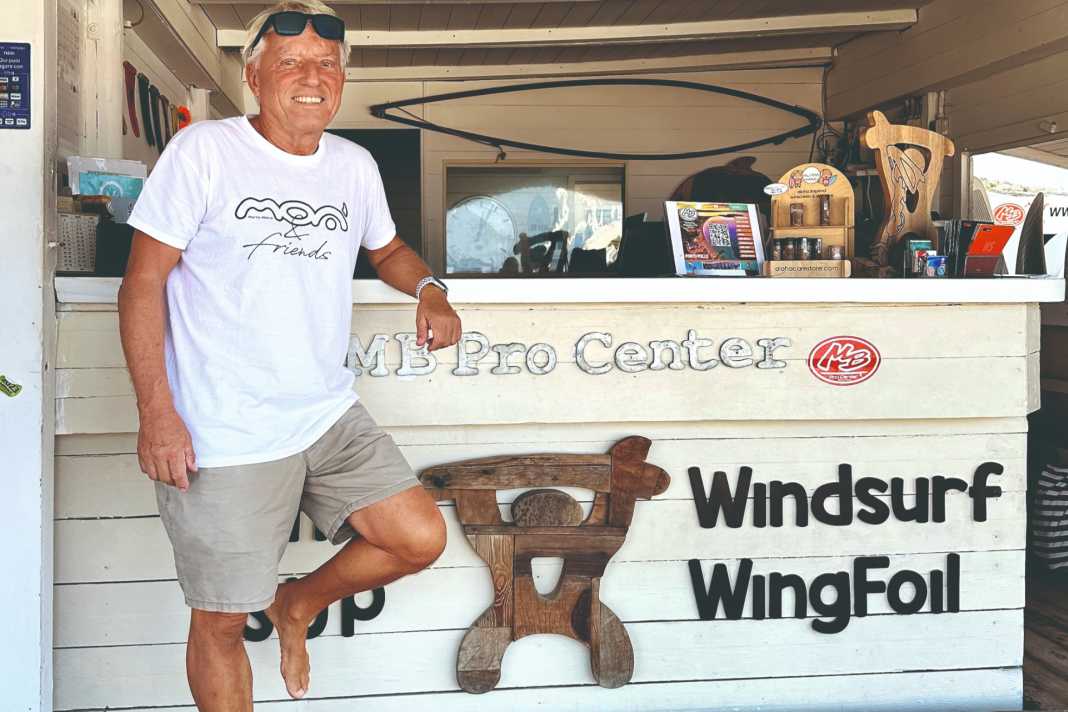





His innovative training methods, an unerring sense for trends and his tough business acumen made Michi Bouwmeester one of the best-known station managers around. His success brought him a lot of recognition, but not necessarily the prize of being everybody's darling. Even now, after almost half a century in the business, Michi is still not thinking about quitting - and looks back on an exciting time in this interview.
Michi, you're currently dismantling your centre in Porto Pollo and putting everything away for the winter. You were born in 1955 - is retirement a foreign concept to you?
I'm still happy when people have fun learning water sports with me. I don't want that to sound pompous, but I enjoy having fun with others. And the pension in Italy isn't that lavish now, so I'll carry on a little longer (laughs).
You've spent your life making it easier for others to start surfing. Can you still remember your own beginnings?
I started back in January 1973 in Holland, and unfortunately there was no one to explain anything back then. I had a wetsuit and a windsurfer from the USA, that was it. Nobody knew how to attach the wooden fork to the mast, let alone how to control the monster. It was all learning by doing. That same year, I taught my first lessons for a local shop in Holland. Looking back, it was a miracle that so many people wanted to surf back then, because the equipment was torture compared to today. You had to be pretty athletic and tough to make it.
You ended up at Lake Garda pretty quickly and Italy became your new home ...
In 1976, I drove to Lake Garda in my Citroën Méhari and founded my first surf school in Salò in the south-west. I continued to compete in regattas on the side. If you wanted to go to the World Championships, you had to compete at national level back then. So on Friday afternoons, after teaching, I would zoom off to Holland at 80 to 90 km/h, 1200 kilometres. The one-piece masts and the long wooden fork hung out the back. I arrived the next morning, won the regatta and then headed back in the evening. By the start of the new working week, I was back at the lake completely exhausted.
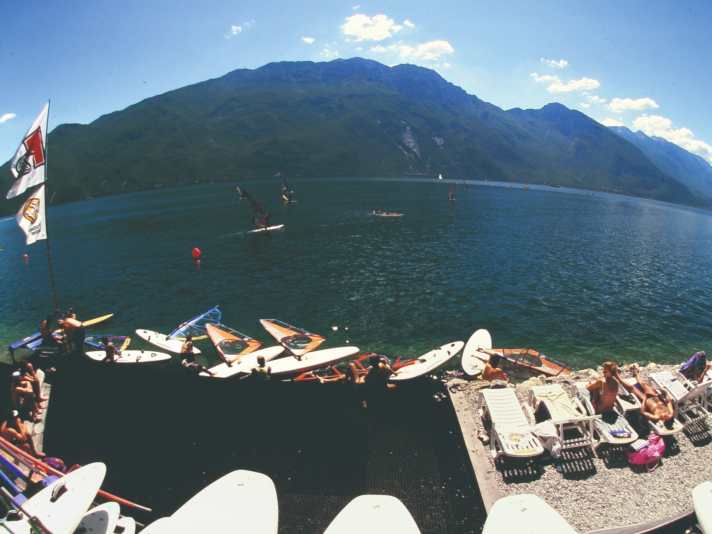
You are regarded as a tough businessman. Was that already the case back then or were regatta successes more important to you at the beginning than a well-running business?
I was already very focussed on regattas. In 1979, I came third in the Windsurfing World Championships, where greats like Robby Naish and Mike Waltze were competing. So I was already successful and then got an offer from HiFly, who wanted me to ride their boards. It was a professional contract that took me to lots of great places all over the world. It was a great time.
How did such a lifestyle go together with a functioning surf business?
Business? Well, you could call it that. My station was 15 boards on the beach, on a single board rack and an old caravan. Back then, everything I earned from the surf school was nice. And if nothing came in, it didn't matter, as I was one of the first professionals at HiFly to have a fixed salary. I continued to train on Lake Garda. In 1979, I won the Engadin surf marathon with 500 starters, ahead of Robby Naish. I'm still proud of that today, having finished ahead of Robby once in my life. Back then, I spent a lot of time on Maui in winter and saw the first fun boards appearing there. It was clear to me that what was popular in Hawaii today would sooner or later spill over to Europe. The first funboard I was able to ride myself, I borrowed from another surfer. The guy was pretty pissed off when I didn't get back ashore until four hours later (laughs). After that, it was clear to me that funboard surfing would be the next big trend - and I wanted to teach it.
Was that also the reason to look for a windier spot on Lake Garda?
Exactly, that was the reason why I moved my surf school to the pier in 1981, it simply had and still has the best wind on Lake Garda. When I got there, the hotel behind the road was practically bankrupt, down on the beach there was nothing but wild wine. I put up a tin hut, some HiFly boards and Pat Love sails and off we went.
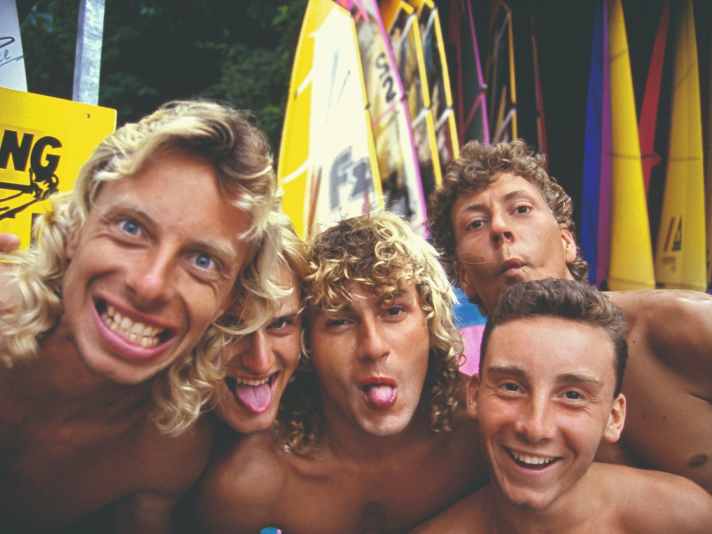
During your time at Lake Garda, you also faced a lot of headwinds and were a thorn in the side of many competitors. How did you manage to assert yourself there?
First and foremost with ideas. There were no teaching programmes for funboard surfing back then. How does a water start work? How do I get into the foot straps? Nobody had any experience. I wrote a course programme and established a level system. Every surf student could immediately see where they stood, what they needed to learn next and, above all, how far they could get. That really hit the spot. Of course, not everyone liked it, there were plenty of envious people. But looking back, you can perhaps say that I had ideas that were new and worked well in the funboard course.
Just like the water start simulator ...
Exactly. The idea came to me during a waterstart course. Until then, waterstart learners were drifting downwind at four knots - so with four wind forces you only had three wind forces in the sail, so you had to pinch people's bums hard to get them on the board. What's more, all the students were completely exhausted after 15 minutes. So I built a pontoon to which the board was fixed two metres downwind at the bow and tail. Suddenly, the students could practise the ascent without drifting off, they had more wind in their sails, I could assist them standing behind them and other students could watch. To this day, I still don't understand why many surf schools still teach how to align in the water first and then how to get on the board. In my opinion, you should do it the other way round. Anyone who swims for minutes in the water to align the equipment is too exhausted to get on the board. Because the training methods were new and well received at the time, it happened time and again that competitors tried to poach my surf instructors. They then offered them double the salary and got a good coach with lots of training expertise in return. You can't blame them for that, but it wasn't always easy to deal with.
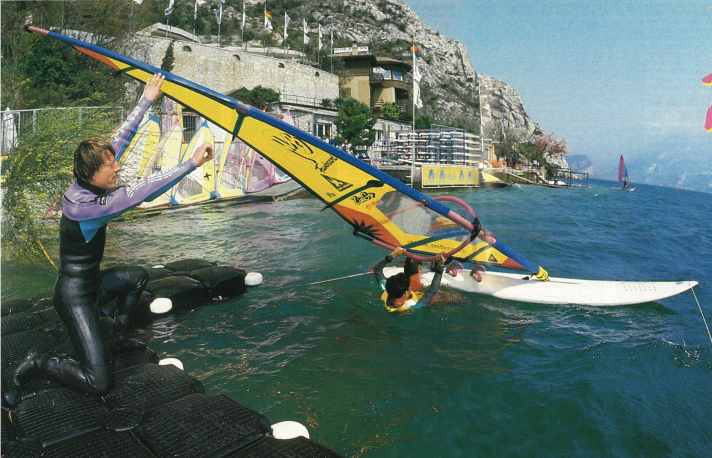
You also produced numerous instructional videos, which were distributed and advertised by Delius Klasing Verlag at the time. Did you finally make a name for yourself internationally in the pre-Internet age?
The instructional videos were a big thing for me. Videos were pretty expensive back then, everything had to be filmed with fat cameras for VHS tapes. For an instructional video on the power jibe, I really wanted to have a perspective where you could look over the surfer's shoulder, so to speak. Only this perspective makes it possible to put yourself in the surfer's shoes. At that time, however, there were neither drones nor small action cams. So we strapped the cameraman to the front of a motorboat, which then followed me a few metres behind. If I had fallen, the boat would probably have flattened me (laughs). But it is precisely these recordings that have helped many surfers to learn moves such as the power jibe.
For many years, the pier was a trendy meeting place. The most colourful birds and many pros were known to hang out there. It all culminated in the legendary King of the Lake events. Why was the pier the "place to be" back then?
People just came, because funboard surfing was possible at the pier. There were legendary coaches, top windsurfers and real freaks, such as Roberto Hofmann (former World Cup presenter, the ed.), Michi Schweiger (current Product Manager at Naish, the ed.), Andy Wolff (German Worldcupper, the ed.) and many others. There was also a dose of "Hawaiian style", as I brought back ideas, new material or lifestyle products from every winter trip to Maui. That was what gave the place its special flair. For the 15th anniversary in 1995, there was to be a big Hawaiian party on the pier. I asked Josh Stone and Jason Polakow if they would like to take part in a fun freestyle contest against the Lake Garda locals and paid for their tickets. There were judges and music on the beach. The surfers hit the water with their loops ten metres from the shore and the crowd went completely wild. It was the first freestyle contest and the birth of the freestyle movement. A year later it became the King of the Lake, and in 1997 even Red Bull got involved.
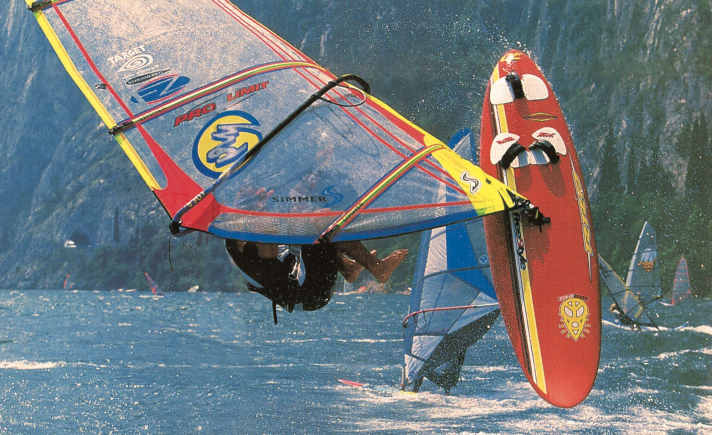
2005 was the end for you at Lake Garda. How did it come about and how hard was that time for you?
On Lake Garda, the concessions for the pitches on the beach were awarded by the province. There was a public tender and you had to bid for the licence. Unfortunately, there were people with excellent contacts in regional politics among the surf school operators who came out on top in the bidding process - and that's all I want to say about that. It was different at the pier, however, as this was a private site belonging to the hotel owner Montagnoli. Unfortunately, the owner took advantage of his negotiating position at the time. Huge sums of money were suddenly demanded in order to organise the King of the Lake. That's why the event later moved to the Conca d'Oro on the other side of the lake. There was more space, of course, but the action was no longer so close to the shore. This meant that the special atmosphere was lost somewhat. The promise to continue using the space on the pier for the school was also tied to ever new demands. There was a dispute, and in the end it even came to a court case. I don't want to rehash exactly what happened back then - but there were things that you only know from gangster films.
After that, you had to reinvent yourself. How did the move to Sardinia come about?
After leaving Lake Garda, I took a break for two years. In 2008, I came to Porto Pollo in Sardinia, where there was surprisingly little going on. The place was great, I realised that straight away. The building on the beach already existed, but there were rats running around. I got the final go-ahead to run a school in February, and within a few months we had to get the centre up and running. I've been here ever since.
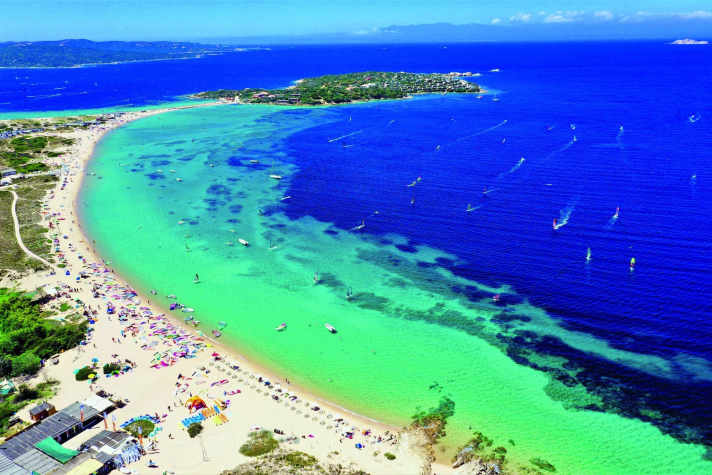
You founded a "Kids Academy" some time ago. What's it all about?
I have transferred the established level system to children's training. It is particularly important for children to be able to learn with people of the same age and suitable material. If you put 6- and 12-year-olds in the same group, it hardly works because the requirements in terms of strength and language are simply completely different. That's why our children's courses are now very finely organised. This requires a lot of organisation, but it's worth it. Learning is a lot of fun, the kids get wristbands for every level they achieve, just like in judo, which makes them really proud and gives them the incentive to reach the next level. At the height of summer, we have up to 40 kids a week on the water here. And if the children are well looked after, you soon have the parents as customers too, because they have more time for themselves.
Windsurfing, SUPing, kitesurfing and now wingfoiling - during your time you have also seen many trends come and go. Where do you see windsurfing today compared to the other sports?
The average windsurfer has got considerably older, no question about it. But many of the first generation of surfers are now coming back with their children. Wingfoiling is expanding the range of use for many towards light winds. My assessment is that foiling is already taking a bit of a toll on classic windsurfing in light winds. However, windsurfing will always have its place in stronger winds.
When the time comes to retire, what are you most looking forward to?
As I said, I'm still having too much fun at the moment. But I certainly won't miss all the paperwork with the authorities, licences and the constant uncertainty that comes with it.

